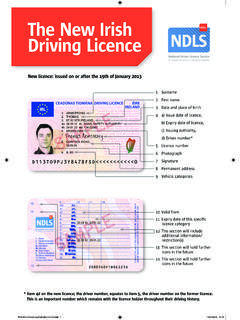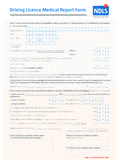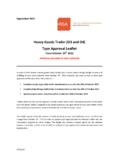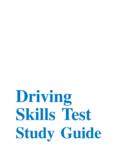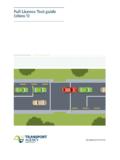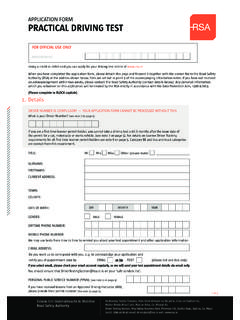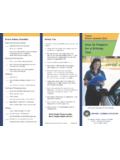Transcription of PREPARING FOR YOUR DRIVING TEST - RSA.ie
1 PREPARINGFOR YOURDRIVING TESTAn t dar s Um Sh bh ilteacht Ar Bh ithreRoad Safety AuthorityThe Road Safety Authority is Working to Save Lives. If you want to pass your DRIVING test make sure your instructor has passed all of ours! Only DRIVING instructors who meet the standard set by the Road Safety Authority can become Approved DRIVING Instructors (ADI). So when you book your DRIVING lessons, make sure it s with a full permit holding Approved DRIVING Instructor. For further details or contactthe ADI Unit on096-25007 find your nearest Approved DRIVING 226/11/08 10:25:35 What is the Purpose of a DRIVING Test?1 The DRIVING test is designed to find out if you:l know the Rules of the Roadl have the knowledge and skill to drive competently in accordance with those rulesl drive with due regard for the safety and convenience of other road usersPreparing for your DRIVING test you should:l study carefully the Rules of the Road bookletl get tuition from an Approved DRIVING Instructor.
2 A list of Approved DRIVING Instructors (ADIs) who have been approved as reaching a high standard can be found by visiting l practise DRIVING as much as possible on all types of roads and in all types of traffic situations, including DRIVING at nightl build up your DRIVING experience and confidence before applying for your testl look out for the RSA suite of Learner Driver manuals which are for sale in bookshops for cars, motorcycles, trucks and :l unnecessarily obstructing traffic or causing annoyance to other road usersl practising on DRIVING test routes for the most part; congestion on these routes causes inconvenience to residents and test applicants Circumstances23 You should advise the driver testing section in advance if you:l have a severe hearing problem or if you are deafl are restricted in your movements or have any disability which could affect your drivingl drive an adapted vehicle, with steering knob, extra hand controls will eliminate delay on the day of your test.
3 If you cannot speak English or are deaf, you are permitted to have an interpreter with you. This person must not be your DRIVING instructor, and the person cannot accompany you on the practical appointmentAppointments for DRIVING tests are arranged in the order in which applications are received. It is the RSA s aim to have a national average waiting time for a DRIVING test of 10 weeks or less. Our ability to meet this target depends on the number of applications received for different centres. Accordingly, the average waiting time in certain DRIVING test centres may vary above or below this 10-week figure. Current waiting times for each centre are available on our website you apply for your test, you may also be able to schedule your own test date. You may only be able to do so if there are dates available for the centre you are applying will normally be given an appointment notice four to five weeks in advance of your test. This will set out the time, date and venue for the test, together with conditions which must be met.
4 Please read this notice carefully as it may help avoid problems on the day of the will also set out the arrangements for cancelling your appointment should this prove vehicleYou must ensure that the vehicle you present to test with meets the requirements for the category of vehicle for that test. This information is provided with your appointment notification. You must also ensure that the vehicle is in a roadworthy learner permitA first-time holder of a Learner Permit (the code 991 will be noted opposite the category on your permit) for licence categories of motorcycle, car and works vehicle (AM,A1,A2,A,B and W) must hold the Learner Permit for six months before taking a DRIVING test. If you fail to meet these conditions, your test will not be conducted on the day and you will lose your Driver Training (EDT) and Initial Basic Training (IBT)A first-time Learner Permit holder for a Car or Motorcycle must take a structured driver training programme with an Approved DRIVING Instructor (ADI) before taking the test.
5 For car learner drivers, this is known as Essential Driver Training (EDT) and applies to those whose first Learner Permit for licence category B has a start date on or after April 4th 2011. Please note that if you are subject to Essential Driver Training (EDT), your test will not be scheduled until your ADI has notified the RSA that you have completed the mandatory 12 lessons. For motorcyclists, this training is known as Initial Basic Training (IBT) and applies to those whose first learner permit for licence category AM, A1, A2, A and M has a category start date on or after December 6th of the TestYou should be present in the waiting area of the test centre before the appointed time of your test. If you are late, the test cannot be conducted and the fee will be forfeited. When you arrive at the test centre, take a seat in the waiting area and you will be called by the Driver driver tester will check your learner permit to establish that it:l relates to youl is current and is valid on the day of the testl is for the correct category of vehicle.
6 You will be asked to read and sign a statement confirming that:l the insurance cover in place is adequate and your vehicle is in a roadworthy conditionThe testThe DRIVING test is cars, it will last about 40 minutes and will include:l questions on the Rules of the Road (including identifying road signs); demonstrating hand signals5l reversing around a cornerl a turnabout in the roadl a hill startl DRIVING approximately 8 kms under a variety of road and traffic conditionsRemember, if you take and pass the test in a vehicle with an automatic transmission, your DRIVING licence will only cover you to drive an automatic DRIVING will be assessed in the following situations:l moving offl DRIVING in trafficl stoppingl reversing round a cornerl turning about to face in the opposite directionl starting on a hilll parkingl road positioningl overtaking and passingl anticipation and observationl use of mirrors and signalsl progressl speedl compliance with traffic lights, road signs and markingsl use of the vehicle controls (accelerator, clutch, gears, brakes and steering)l use of secondary controls such as wipers, demisters, etc.
7 67 Other aspects of the DRIVING test will check that:l you know how to operate the secondary controls, such as windscreen wipers and washers, demisters, rear window heater, lights and air-conditioning (where fitted)l you must also know how to adjust the seat, safety belt, head restraint and mirrors and ensure the doors are closedl in the case of a motorcycle test, you must be able to remove the motorcycle from its stand. You must also know how to adjust your helmet. Motorcyclists must also demonstrate a braking manoeuvre and an avoid the obstacle manoeuvrel in the case of a vehicle and trailer, you must know how to uncouple and recouple the trailer from/to the drawing vehiclel in the case of a heavy vehicle test, you must know how to check the power-assisted braking and steering systems, and how to use any retarder or exhaust brake as fitted to the vehiclel you know how to perform a check on the tyres, lights, reflectors, indicators, engine oil, coolant, windscreen washer fluid, steering, brakes and horn.
8 For motorcyclists, the checks can also include the chain, and the emergency stop-switch, if fittedl in the case of a bus test, you must also know how to operate the fuel shut-off valve, the main power switch, and how to manually open and close any powered doors as fitted to the vehicleUseful informationl the driver tester understands that you may be nervous and will try to put you at easel unlike your instructor, the driver tester will not offer you encouragement or advice. You should not be put off by this formal approach which is designed to ensure fairness to all applicantsl while you will be given clear directions throughout the test, should you not understand a particular direction, ask the tester to repeat or clarify it7l if you make a mistake, do not worry unduly. It may not be as serious as it appears and may not mean you have failed your testl passengers other than the driver tester and/or RSA officials are not permitted to accompany you in the vehicle during the practical test.
9 The tester may be accompanied on test for training/supervisory purposes. While the accompanying officer may take notes, s/he has no input into the conduct or outcome of the test. Common Faults Contributing to Test FailureThe following are the most common faults which give rise to candidates failing their DRIVING test:l inadequate observation moving off, at junctions, at roundabouts and when changing lanesl failure to anticipate the actions of other driversl incorrect road position on the straight, on bends, turning left, turning right, at roundabouts, and when overtakingl inadequate progress at junctions, roundabouts, on the straight, and when overtakingl incorrect, inadequate or inappropriate use of mirrors and signalsl non-compliance with traffic controls, road signs and markings and traffic lights89l incorrect, inadequate or inappropriate use of vehicle controls, including gears, clutch, accelerator, steering, handbrake, footbrake, and secondary controlsl excessive speed for the road or traffic conditionsl failure to yield the right of way to othersl lack of competence in the reverse and turnabout manoeuvresFaults by motorcyclists also include.
10 L failure to perform a u turn correctlyl inadequate control at slow speedl inadequate observations to the rearl incorrect or inadequate hand-signalsl lack of competence in specific manoeuvresThe list of faults highlighted above is by no means exhaustive. You should study the Rules of the Road carefully and get as much practice as possible, in all types of traffic situations, in preparation for your DRIVING Test ResultIf you pass:You will get a certificate of competency to drive. This enables you to apply for a full DRIVING licence (further information is available from the National Driver Licence Service at ). The certificate is valid for two years. You should take out a full licence within that period or you will be obliged to pass the DRIVING test again in order to obtain a full licence (for this reason you should apply for your full licence immediately). Remember, passing the DRIVING test is not the end of the learning process; so continue to drive carefully and build up your experience in different traffic, weather, lighting and road you fail:You will receive a detailed report on the faults which occurred during the test.


